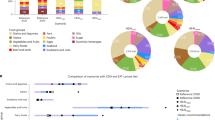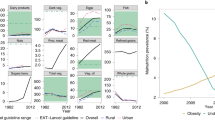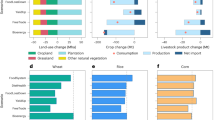Abstract
Food systems are essential for the achievement of the United Nations Sustainable Development Goals in China. Here, using an integrated assessment modelling framework that considers country-specific pathways and covers 18 indicators, we find that most social and environmental targets for the Chinese food system under current trends are not aligned with the United Nations Agenda 2030. We further quantify the impacts of multiple measures, revealing potential trade-offs in pursuing strategies aimed at public health, environmental sustainability and livelihood improvement in isolation. Among the individual packages of measures, a shift towards healthy diets exhibits the lowest level of trade-offs, leading to improvements in nutrition, health, environment and livelihoods. In contrast, focusing efforts on climate change mitigation and ecological conservation, or promoting faster socioeconomic development alone, have trade-offs between social and environmental outcomes. These trade-offs could be minimized by bundling all three aspects of measures.
This is a preview of subscription content, access via your institution
Access options
Access Nature and 54 other Nature Portfolio journals
Get Nature+, our best-value online-access subscription
$32.99 / 30 days
cancel any time
Subscribe to this journal
Receive 12 digital issues and online access to articles
$119.00 per year
only $9.92 per issue
Buy this article
- Purchase on SpringerLink
- Instant access to full article PDF
Prices may be subject to local taxes which are calculated during checkout




Similar content being viewed by others
Data availability
More details can be found in Methods and Supplementary Information. Source data are provided with this paper.
Code availability
The MAgPIE code, including the food demand model, is available under the GNU Affero General Public License, version 3 (AGPLv3) via GitHub at https://github.com/magpiemodel/magpie. The release used in this paper (version 4.6.5) is available via Zenodo at https://doi.org/10.5281/zenodo.7782037 (ref. 72). The technical model documentation is available at https://rse.pik-potsdam.de/doc/magpie/4.6.5/. Additional codes and details for all the participating models tailored to China can be provided upon reasonable request. Data analysis was conducted using R (version 4.1.3), GAMS (version 38.3.0) and the libraries of Potsdam Integrated Assessment Modelling via GitHub at https://github.com/pik-piam.
References
Wang, X., Bodirsky, B. L., Müller, C., Chen, K. Z. & Yuan, C. The triple benefits of slimming and greening the Chinese food system. Nat. Food 3, 686–693 (2022).
Wang, X. et al. Reforming China’s fertilizer policies: implications for nitrogen pollution reduction and food security. Sustain. Sci. 18, 407–420 (2023).
Yu, C. et al. Managing nitrogen to restore water quality in China. Nature 567, 516–520 (2019).
He, Y. et al. The dietary transition and its association with cardiometabolic mortality among Chinese adults, 1982–2012: a cross-sectional population-based study. Lancet Diabetes Endocrinol. 7, 540–548 (2019).
Chen, H. et al. Plant-based dietary patterns in relation to mortality among older adults in China. Nat. Aging 2, 224–230 (2022).
Repositioning Nutrition as Central to Development: a Strategy for Large Scale Action (World Bank, 2006).
Liu, J., Lundqvist, J., Weinberg, J. & Gustafsson, J. Food losses and waste in China and their implication for water and land. Environ. Sci. Technol. 47, 10137–10144 (2013).
Gong, P. et al. Urbanisation and health in China. Lancet 379, 843–852 (2012).
Zhai, F. et al. Dynamics of the Chinese diet and the role of urbanicity, 1991–2011. Obes. Rev. 15, 16–26 (2014).
UNFSS Action Tracks. United Nations https://www.un.org/en/food-systems-summit/action-tracks (2022).
Poore, J. & Nemecek, T. Reducing food’s environmental impacts through producers and consumers. Science 360, 987–992 (2018).
Willett, W. et al. Food in the Anthropocene: the EAT–Lancet Commission on healthy diets from sustainable food systems. Lancet 393, 447–492 (2019).
Springmann, M. et al. Options for keeping the food system within environmental limits. Nature 562, 519–525 (2018).
Breure, T. S. et al. A systematic review of the methodology of trade-off analysis in agriculture. Nat. Food 5, 211–220 (2024).
Soergel, B. et al. A sustainable development pathway for climate action within the UN 2030 Agenda. Nat. Clim. Change 11, 656–664 (2021).
Bodirsky, B. et al. A food system transformation can enhance global health, environmental conditions and social inclusion. Preprint at https://doi.org/10.21203/rs.3.rs-2928708/v1 (2023).
O’Neill, B. C. et al. The roads ahead: narratives for shared socioeconomic pathways describing world futures in the 21st century. Global Environ. Change 42, 169–180 (2017).
Popp, A. et al. Land-use futures in the shared socio-economic pathways. Global Environ. Change 42, 331–345 (2017).
Chinese Nutrition Society. Chinese Dietary Guidelines (eds Wang, F. et al.) (People’s Medical Publishing House, 2022).
Chen, P., Li, F. & Harmer, P. Healthy China 2030: moving from blueprint to action with a new focus on public health. Lancet Public Health 4, e447 (2019).
Notice of the State Council on Printing and Distributing the Action Plan for the Prevention and Control of Soil Pollution (The State Council, 2015); http://www.gov.cn/zhengce/content/2016-05/31/content_5078377.htm
Notice of the State Council on Printing and Distributing the Action Plan for the Prevention and Control of Air Pollution (The State Council, 2013); http://www.gov.cn/zwgk/2013-09/12/content_2486773.htm
Notice of the State Council on Printing and Distributing the Action Plan for the Prevention and Control of Water Pollution (The State Council, 2015); http://www.gov.cn/zhengce/content/2015-04/16/content_9613.htm
Kunming–Montreal Global Biodiversity Framework. CBD/COP/15/L25 (Convention on Biological Diversity, 2022); https://www.cbd.int/conferences/2021-2022/cop-15/documents
Soergel, B. et al. Combining ambitious climate policies with efforts to eradicate poverty. Nat. Commun. 12, 2342 (2021).
2021 Global Food Policy Report: Transforming Food Systems after COVID-19 (International Food Policy Research Institute, 2021); https://ebrary.ifpri.org/digital/collection/p15738coll2/id/134343
Wang, X. et al. Taking account of governance: Implications for land-use dynamics, food prices, and trade patterns. Ecol. Econ. 122, 12–24 (2016).
Wang, X. et al. Beyond land-use intensity: assessing future global crop productivity growth under different socioeconomic pathways. Technol. Forecast. Soc. Change 160, 120208 (2020).
Evenson, R. E. & Gollin, D. Assessing the impact of the green revolution, 1960 to 2000. Science 300, 758–762 (2003).
Jones, S. K., Monjeau, A., Perez-Guzman, K. & Harrison, P. A. Integrated modeling to achieve global goals: lessons from the Food, Agriculture, Biodiversity, Land-use, and Energy (FABLE) initiative. Sustain. Sci. 18, 323–333 (2023).
Mosnier, A. et al. How can diverse national food and land-use priorities be reconciled with global sustainability targets? Lessons from the FABLE initiative. Sustain. Sci. 18, 335–345 (2023).
Dietrich, J. P. et al. MAgPIE 4—a modular open-source framework for modeling global land systems. Geosci. Model Dev. 12, 1299–1317 (2019).
Lotze-Campen, H. et al. Global food demand, productivity growth, and the scarcity of land and water resources: a spatially explicit mathematical programming approach. Agric. Econ. https://doi.org/10.1111/j.1574-0862.2008.00336.x (2008).
Guidelines of the Eleventh Five-Year Plan for National Economic and Social Development (National Development and Reform Commission, 2006); https://www.gov.cn/gongbao/content/2006/content_268766.htm
Opinions of Applying the Strictest Water Resources Control System (The State Council, 2012); https://www.gov.cn/zhuanti/2015-06/13/content_2878992.htm
Schneider, K. R. et al. The state of food systems worldwide in the countdown to 2030. Nat. Food 4, 1090–1110 (2023).
Popkin, B. M., Corvalan, C. & Grummer-Strawn, L. M. Dynamics of the double burden of malnutrition and the changing nutrition reality. Lancet 395, 65–74 (2020).
Chang, J. et al. Reconciling regional nitrogen boundaries with global food security. Nat. Food 2, 700–711 (2021).
Stevanović, M. et al. The impact of high-end climate change on agricultural welfare. Sci. Adv. 2, e1501452 (2016).
Hsiang, S. et al. Estimating economic damage from climate change in the United States. Science https://doi.org/10.1126/science.aal4369 (2017).
Hasegawa, T. et al. Risk of increased food insecurity under stringent global climate change mitigation policy. Nat. Clim. Change 8, 699–703 (2018).
Fanzo, J. et al. Viewpoint: rigorous monitoring is necessary to guide food system transformation in the countdown to the 2030 global goals. Food Policy 104, 102163 (2021).
Jaureguiberry, P. et al. The direct drivers of recent global anthropogenic biodiversity loss. Sci. Adv. 8, eabm9982 (2022).
Employment by Sex, Age and Economic Activity (Thousands) (ILOSTAT, 2024); https://ilostat.ilo.org/data/
Agricultural Policy Monitoring and Evaluation 2022: Reforming Agricultural Policies for Climate Change Mitigation (OECD, 2022); https://doi.org/10.1787/7f4542bf-en
Bodirsky, B. L. et al. The ongoing nutrition transition thwarts long-term targets for food security, public health and environmental protection. Sci. Rep. 10, 19778 (2020).
Gautam, M. et al. Repurposing Agricultural Policies and Support: Options to Transform Agriculture and Food Systems to Better Serve the Health of People, Economies, and the Planet (World Bank, 2022); https://doi.org/10.1596/36875
Humpenöder, F. et al. Investigating afforestation and bioenergy CCS as climate change mitigation strategies. Environ. Res. Lett. 9, 064029 (2014).
Eker, S., Reese, G. & Obersteiner, M. Modelling the drivers of a widespread shift to sustainable diets. Nat. Sustain. 2, 725–735 (2019).
Bauer, J. M., Bietz, S., Rauber, J. & Reisch, L. A. Nudging healthier food choices in a cafeteria setting: a sequential multi-intervention field study. Appetite 160, 105106 (2021).
Balcombe, K., Fraser, I., Lowe, B. & Souza Monteiro, D. Information customization and food choice. Am. J. Agric. Econ. 98, 54–73 (2016).
Clark, M. A., Springmann, M., Hill, J. & Tilman, D. Multiple health and environmental impacts of foods. Proc. Natl Acad. Sci. USA 116, 23357–23362 (2019).
Faccioli, M. et al. Combined carbon and health taxes outperform single-purpose information or fiscal measures in designing sustainable food policies. Nat. Food 3, 331–340 (2022).
2022 Global Food Policy Report: Climate Change and Food Systems (International Food Policy Research Institute, 2022); https://ebrary.ifpri.org/digital/collection/p15738coll2/id/135889
Prag, A., Lyon, T. & Russillo, A. Multiplication of Environmental Labelling and Information Schemes (ELIS): Implications for Environment and Trade (OECD, 2016); https://doi.org/10.1787/5jm0p33z27wf-en
von Bloh, W. et al. Implementing the nitrogen cycle into the dynamic global vegetation, hydrology, and crop growth model LPJmL (version 5.0). Geosci. Model Dev. 11, 2789–2812 (2018).
Scholes, R. J. & Biggs, R. A biodiversity intactness index. Nature 434, 45–49 (2005).
Purvis, A. et al. in Advances in Ecological Research (eds Bohan, D. A., Dumbrell, A. J., Woodward, G. & Jackson, M.) Vol. 58, 201–241 (Academic, 2018).
Baumstark, L. et al. REMIND2.1: transformation and innovation dynamics of the energy-economic system within climate and sustainability limits. Geosci. Model Dev. 14, 6571–6603 (2021).
Springmann, M. Health and nutritional aspects of sustainable diet strategies and their association with environmental impacts: a global modelling analysis with country-level detail. Lancet Planet. Health 2, e451–e461 (2018).
GBD 2019 Demographics Collaborators.Global age-sex-specific fertility, mortality, healthy life expectancy (HALE), and population estimates in 204 countries and territories, 1950–2019: a comprehensive demographic analysis for the Global Burden of Disease Study 2019. Lancet 396, 1160–1203 (2020).
Aune, D. et al. Fruit and vegetable intake and the risk of cardiovascular disease, total cancer and all-cause mortality—a systematic review and dose-response meta-analysis of prospective studies. Int. J. Epidemiol. 46, 1029–1056 (2017).
The Global BMI Mortality Collaboration.Body-mass index and all-cause mortality: individual-participant-data meta-analysis of 239 prospective studies in four continents. Lancet 388, 776–786 (2016).
Schwingshackl, L. et al. Food groups and risk of colorectal cancer: food groups and colorectal cancer. Int. J. Cancer 142, 1748–1758 (2018).
Bechthold, A. et al. Food groups and risk of coronary heart disease, stroke and heart failure: a systematic review and dose-response meta-analysis of prospective studies. Crit. Rev. Food Sci. Nutr 59, 1071–1090 (2019).
Yuan, Y.-Q. et al. The development of a Chinese healthy eating index and its application in the general population. Nutrients 9, 977 (2017).
Ren, Y., Zhao, J., Glauben, T. & Castro Campos, B. Supermarket environment and nutrition outcomes: evidence from rural China. J. Rural Stud. 92, 79–92 (2022).
Stubbendorff, A. et al. Development of an EAT–Lancet index and its relation to mortality in a Swedish population. Am J. Clin. Nutr. 115, 705–716 (2022).
Rao, N. D., Sauer, P., Gidden, M. & Riahi, K. Income inequality projections for the Shared Socioeconomic Pathways (SSPs). Futures 105, 27–39 (2019).
Database collection of the Food and Agriculture Organization of the United Nations (FAOSTAT, 2015).
Kreidenweis, U. et al. Afforestation to mitigate climate change: impacts on food prices under consideration of albedo effects. Environ. Res. Lett. 11, 085001 (2016).
Dietrich, J. P. et al. MAgPIE—an open source land-use modeling framework. Zenodo https://doi.org/10.5281/zenodo.7782037 (2023).
Acknowledgements
X.W., H. Cai, J.X., R.D., B.L. and M.X. were supported by the National Science Foundation of China (grant nos. 72273126, 72134006 and 72074193). L.Y. acknowledges funding from the National Science Foundation of China (grant no. 72104213), and the Fundamental Research Funds for the Central Universities. X.W., L.Y., H. Cai, J.X., R.D., B.L. and M.X. acknowledge funding from the National Key Research and Development Program of China (grant no. 2020YFA0608604). X.W., H. Cai, J.X., R.D., B.L., B.L.B., M. Stevanović, Q.C., M.C., F.B., M.X., M. Springmann, D.L., D.M.-C.C., F.H., P.v.J., B.S., J.P.D., A.P. and H.L.-C. acknowledge support from Food System Economics Commission (G-2009-01682). M. Springmann acknowledges funding from Wellcome Trust (award no. 225318/Z/22/Z). D.L. acknowledges funding from Hans-Böckler-Stiftung’s Doctoral Scholarship. X.W. acknowledges support from the Key Research Base for Humanities and Social Sciences under the Ministry of Education (22JJD790075). X.W., C.Y., H. Chen, H. Cai, J.X., R.D., B.L. and M.X. acknowledge support from the Fundamental Research Funds for the Central Universities.
Author information
Authors and Affiliations
Contributions
X.W., B.L.B., M. Stevanović and H.L.-C. conceptualized the study. X.W., H. Cai, J.X., R.D., B.L., B.L.B., M. Stevanović, C.Y., M.C., F.B., M.X., H. Chen, M. Springmann, D.L., D.M.-C.C., F.H., P.v.J., B.S., J.P.D., C.M., A.P. and H.L.-C. contributed data and devised the methodology. X.W., H. Cai, J.X., R.D., B.L., B.L.B., M. Stevanović and H.L.-C. performed the analysis and interpreted the results. H. Cai, J.X., R.D., M.C. and X.W. produced the visualizations. X.W. and H.L.-C. acquired the funding. X.W., M. Stevanović, Q.C. and H.L.-C. managed the project administration. X.W., H. Cai, J.X., R.D., B.L. and L.Y. wrote the original draft. X.W., H. Cai, J.X., R.D., B.L., B.L.B., M. Stevanović, C.Y., L.Y., M.C., D.M.-C.C., S.F., B.S., J.P.D., C.M., A.P. and H.L.-C. participated in discussing the results. All authors contributed to reviewing and editing the manuscript.
Corresponding authors
Ethics declarations
Competing interests
The authors declare no competing interests.
Peer review
Peer review information
Nature Food thanks Ilona Otto, Kate Schneider and the other, anonymous, reviewer(s) for their contribution to the peer review of this work.
Additional information
Publisher’s note Springer Nature remains neutral with regard to jurisdictional claims in published maps and institutional affiliations.
Extended data
Extended Data Fig. 1 Scenario design and description of the food system transformation measures.
The three package scenarios, Diets, SustEnvironment, and Livelihoods are designed based on the BASESSP2 scenario with specific measures targeting progress on public health, the environment, and livelihoods, respectively. The FSTSDP_China is a holistic food system transformation pathway including all measures in the three package scenarios. Credit: icons, Freepik.com.
Extended Data Fig. 2 Health, environmental, and livelihood indicators associated with the Chinese food system under the scenarios of BASESSP2, FSTSDP_China, three package measures, and individual measures.
The colour schemes indicate positive (green) and negative (red) impacts on indicators relative to the values in the 2050 BASESSP2 scenario. Grey cells with values indicate that these output indicators are not affected by the policy measures of the respective scenarios.
Extended Data Fig. 3 Details about co-developments of indicators related to public health, the environment, and livelihoods in the Chinese food system under the FSTSDP_China, and three package scenarios.
a, Co-developments of indicators under the FSTSDP_China scenario. b, Co-developments of indicators under the Diets scenario. c, Co-developments of indicators under the SustEnvironment scenario. d, Co-developments of indicators under the Livelihoods scenario. The red color indicates a trade-off between two indicators, while the green color indicates a co-benefit. The grey color suggests no interaction between the two indicators in this scenario. The purple color indicates both indicators are deteriorating in the respective scenario. A plus sign following the indicator’s name suggests that a higher value is favorable, while a minus sign indicates that a lower value is preferable. Notably, drivers of these co-developments are the measures within the respective policy set and we do not imply any direct correlations between each pair of indicators.
Supplementary information
Supplementary Information
Supplementary Methods, sensitivity analysis, Figs. 1–27 and Tables 1–3.
Source data
Source Data Fig. 2
Source data from the model results to generate Fig. 2.
Source Data Fig. 3
Source data from the model results to generate Fig. 3.
Source Data Fig. 4
Source data from the model results to generate Fig. 4.
Source Data Extended Data Fig. 3
Source data from the model results to generate Extended Data Fig. 3.
Rights and permissions
Springer Nature or its licensor (e.g. a society or other partner) holds exclusive rights to this article under a publishing agreement with the author(s) or other rightsholder(s); author self-archiving of the accepted manuscript version of this article is solely governed by the terms of such publishing agreement and applicable law.
About this article
Cite this article
Wang, X., Cai, H., Xuan, J. et al. Bundled measures for China’s food system transformation reveal social and environmental co-benefits. Nat Food 6, 72–84 (2025). https://doi.org/10.1038/s43016-024-01100-z
Received:
Accepted:
Published:
Issue date:
DOI: https://doi.org/10.1038/s43016-024-01100-z
This article is cited by
-
Multi-benefit diet changes in China
Nature Sustainability (2025)
-
The multiple benefits of Chinese dietary transformation
Nature Sustainability (2025)
-
Eastern healthy dietary patterns in relation to all-cause mortality
European Journal of Nutrition (2025)



